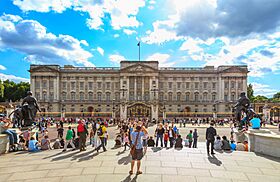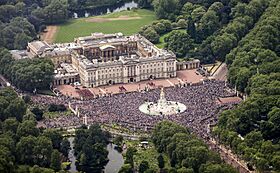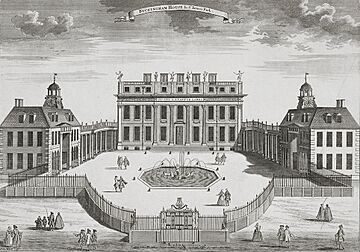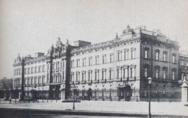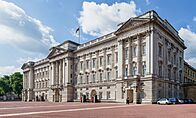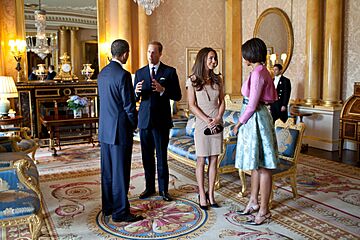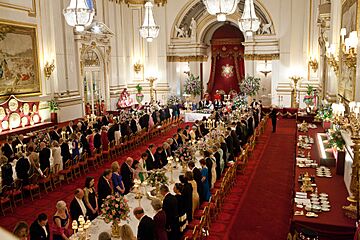Buckingham Palace facts for kids
Buckingham Palace is a famous royal home in London, England. It is the main office for the King or Queen of the United Kingdom. The palace is in the City of Westminster and is often used for important national events and royal parties. It has been a special place for the British people during times of great happiness and sadness.
The building we see today started as a large house called Buckingham House. It was built in 1703 for the Duke of Buckingham and Normanby. Later, in 1761, George III bought it as a private home for his wife, Queen Charlotte. It was then known as The Queen's House. During the 1800s, the house was made much bigger by architects John Nash and Edward Blore. They added three wings around a central courtyard. Buckingham Palace became the main London home for the British monarch when Queen Victoria became Queen in 1837.
The last big additions were made in the late 1800s and early 1900s. This included the East Front, which has the famous balcony where the royal family often waves to crowds. During the Second World War, a German bomb destroyed the palace chapel. The King's Gallery was later built on this spot and opened in 1962. It shows amazing art from the Royal Collection.
Many of the palace's original designs from the early 1800s are still there. These include bright colours and special stones like blue and pink lapis. King Edward VII later changed some rooms to a cream and gold style. Many smaller rooms are decorated in a Chinese style, with furniture from the Royal Pavilion in Brighton. The palace has 775 rooms, and its garden is the biggest private garden in London. The grand "state rooms," used for official events, are open to the public for parts of August and September, and on some days in winter and spring.
Contents
History of Buckingham Palace
Early Days of the Palace Site
Long ago, in the Middle Ages, the land where Buckingham Palace now stands was part of a large area called the Manor of Ebury. A river called the Tyburn flowed through this marshy land. This river still runs under the palace today! The land changed owners many times. Important people like Edward the Confessor and William the Conqueror once owned it. William gave the land to Geoffrey de Mandeville, who then gave it to the monks of Westminster Abbey.
In 1531, Henry VIII took over some land nearby, which became St James's Palace. In 1536, he also took the Manor of Ebury from Westminster Abbey. This meant the land for Buckingham Palace was back in royal hands after almost 500 years! Later, in the 1600s, James VI and I sold some of the land but kept a part where he planted a mulberry garden. He hoped to produce silk there. This garden was in the northwest corner of where the palace is now.
First Houses on the Land (1624–1761)
Around 1624, William Blake built possibly the first house on this land. The next owner, George Goring, 1st Earl of Norwich, made Blake's house bigger starting in 1633. This house became known as Goring House. He also created much of what is now the palace garden.
Later, in 1674, Goring House burned down. Henry Bennet, 1st Earl of Arlington then built Arlington House on the same spot. This is where the southern part of today's palace stands. In 1698, John Sheffield took over the lease. He built Buckingham House in 1703. It was a large, three-story building with two smaller wings. In 1761, Sheffield's son sold Buckingham House to George III for £21,000.
From Queen's House to Palace (1761–1837)

When George III bought Buckingham House, it was meant to be a private getaway for his wife, Queen Charlotte. So, it was called The Queen's House. They started changing the building in 1762. Queen Charlotte had 14 of her 15 children born there. Even though St James's Palace was still the official royal home, people started calling it "Buckingham Palace" by 1791.
After George IV became King in 1820, he continued to renovate the house. He wanted a small, comfortable home. But in 1826, he decided to turn it into a grand palace with his architect, John Nash. The cost of these changes grew very high, and Nash was removed as architect in 1829. When George IV died in 1830, his brother William IV hired Edward Blore to finish the work. William IV never actually lived in the palace. He even offered to turn it into the new Houses of Parliament after the old one burned down in 1834, but his offer was not accepted.
Queen Victoria's Time (1837–1901)

Buckingham Palace became the main royal home in 1837 when Queen Victoria became Queen. She was the first monarch to live there. At first, the palace had some problems. The chimneys smoked, making rooms cold, and the ventilation was poor. After Queen Victoria married Prince Albert in 1840, he helped fix these issues and reorganize the palace staff.
By 1847, the Queen and Prince Albert found the palace too small for their growing family and royal events. A new wing, designed by Edward Blore, was built between 1847 and 1849. This new wing enclosed the central courtyard. The money for this came from selling the Brighton Pavilion. The large East Front, which faces The Mall, is now the "public face" of Buckingham Palace. It has the famous balcony where the royal family appears for big events like the annual Trooping the Colour. Before Prince Albert's death, the palace was a lively place with grand parties and musical performances. Famous musicians like Felix Mendelssohn and Johann Strauss II played there.
After Prince Albert died in 1861, Queen Victoria was very sad. She left Buckingham Palace and spent many years living at Windsor Castle, Balmoral Castle, and Osborne House. For a long time, the palace was hardly used. Eventually, people encouraged the Queen to return to London, but she still preferred to live elsewhere when she could.
Early 1900s (1901–1945)
In 1901, the new King, Edward VII, started redecorating the palace. He and his wife, Queen Alexandra, were very fashionable. Buckingham Palace became a grand place for entertaining again, with many rooms redecorated in a cream and gold style.
The last major building work happened during the reign of George V. In 1913, Aston Webb redesigned the East Front to look like a grand country house. This new front, made of Portland stone, became the backdrop for the Victoria Memorial, a large statue of Queen Victoria outside the palace gates. King George V was more serious than his father. He focused more on official duties and less on lavish parties. He even arranged special performances featuring jazz musicians like the Original Dixieland Jazz Band and Louis Armstrong.
During the First World War (1914-1918), the palace was not damaged. Valuable items were moved to Windsor Castle, but the royal family stayed. The King introduced rationing at the palace to set an example.
King George V's wife, Queen Mary, loved art and helped restore and add to the Royal Collection of furniture and art. She also added new decorations, like marble fireplaces. In 1938, a part of the palace that was once a conservatory was turned into a swimming pool.
Second World War and the Palace
During the Second World War, which began in 1939, Buckingham Palace was bombed nine times. The most serious attack destroyed the palace chapel in 1940. A bomb fell in the palace courtyard while George VI and Queen Elizabeth (the future Queen Mother) were inside. Many windows were broken, and the chapel was ruined. The King and Queen were filmed inspecting their bombed home. This newsreel was shown in cinemas to show that everyone, rich or poor, was suffering together. Queen Elizabeth famously said, "I'm glad we have been bombed. Now I can look the East End in the face," meaning she shared the experience of ordinary Londoners.
On 15 September 1940, during the Battle of Britain Day, an RAF pilot named Ray Holmes bravely rammed a German bomber he thought was going to bomb the palace. He ran out of bullets, so he decided to crash into it. He parachuted out safely, and the bomber crashed near London Victoria station. After the war, the damaged palace was carefully repaired.
On VE Day (Victory in Europe Day) on 8 May 1945, the palace was the center of celebrations in Britain. The King, the Queen, Princess Elizabeth (who would become Queen), and Princess Margaret appeared on the balcony. Huge crowds cheered them in The Mall.
From Mid-1900s to Today

Many of the palace's treasures are part of the Royal Collection. You can sometimes see them at the King's Gallery, which is near the Royal Mews. This gallery opened in 1962 on the site of the chapel destroyed in World War II. It shows different items from the collection. The palace was made a Grade I listed building in 1970, meaning it's a very important historic building. Its state rooms have been open to the public during August and September, and on some other days, since 1993. The money from tickets first helped rebuild Windsor Castle after a fire in 1992.
Buckingham Palace, like Windsor Castle, is owned by the King or Queen as part of their role as monarch. It is not their personal property. The Government of the United Kingdom is responsible for keeping the palace in good condition. In 2015, the State Dining Room had to close because its ceiling was unsafe. A big 10-year plan to fix the palace's plumbing, wiring, and heating, costing £369 million, was approved in 2016. This work will help the building last for at least another 50 years.
Buckingham Palace is a very important symbol and home of the British monarchy. It is also an art gallery and a popular place for tourists. The famous front of the palace, designed by Aston Webb, looks "like everybody's idea of a palace." It was the weekday home of Queen Elizabeth II and Prince Philip for many years. It is also the London office for some other members of the royal family. More than 800 people work there. Charles III and Queen Camilla live at Clarence House while the palace is being renovated, but they do official work at Buckingham Palace.
Every year, about 50,000 guests are invited to parties, receptions, and banquets at the palace. Three garden parties are usually held in the summer. The front courtyard of Buckingham Palace is used for the Changing of the Guard, a popular ceremony and tourist attraction.
Inside the Palace
The palace is huge! It is 108 meters (about 354 feet) wide, 120 meters (about 394 feet) deep, and 24 meters (about 79 feet) high. It has over 77,000 square meters (about 828,821 square feet) of floor space. There are 775 rooms, including 188 bedrooms for staff, 92 offices, 78 bathrooms, 52 main bedrooms, and 19 grand "state rooms." It also has its own post office, cinema, swimming pool, doctor's office, and a workshop for jewelry. The royal family lives in a small set of private rooms in the north wing.
Main Rooms
The most important rooms are on the first floor, behind the garden-facing side of the palace. In the center of these grand rooms is the Music Room, which has a large curved window. On either side of the Music Room are the Blue and White Drawing Rooms. Connecting these rooms is the Picture Gallery, which is 55 yards (about 50 meters) long and has light coming from above. The gallery displays many famous paintings by artists like Rembrandt, van Dyck, Rubens, and Vermeer. Other rooms leading from the Picture Gallery are the Throne Room and the Green Drawing Room. The Green Drawing Room is a large waiting room for the Throne Room. These very formal rooms are used only for special ceremonies and official events, but they are open to the public every summer.
Less Formal Rooms
Right below the main state rooms are the less formal "semi-state apartments." These rooms are used for smaller gatherings, like lunch parties and private meetings. In the center of this floor is the Bow Room, where thousands of guests walk through each year to attend the King's garden parties.
When foreign leaders visit Britain, they are usually hosted by the King at Buckingham Palace. They stay in a large set of rooms called the Belgian Suite. Some of these rooms are named after important visitors, like the 1844 Room, which was decorated for the visit of Nicholas I of Russia in that year. The 1855 Room honors the visit of Napoleon III of France. The 1844 Room is a sitting room that is also used for meetings and sometimes for awarding honors. The Belgian Suite was named after Leopold I of Belgium, who was Queen Victoria's uncle.
East Wing

Between 1847 and 1850, when the new east wing was being built, many decorations from the Brighton Pavilion were used. Because of this, many rooms in the new wing have an Asian feel. The red and blue Chinese Luncheon Room has parts from Brighton's Banqueting and Music Rooms. It also has a large fireplace designed in an Asian style. The beautiful clock in this room, called the Kylin Clock, was made in China in the 1700s. The Yellow Drawing Room has hand-painted Chinese wallpaper from 1817 and a fireplace that looks like a European idea of a Chinese fireplace.
In the center of this wing is the famous balcony, with the Centre Room behind its glass doors. This room has a Chinese style, made even more special by Queen Mary in the late 1920s. Along the entire length of the east wing's main floor is the Great Gallery, also known as the Principal Corridor. It has mirrored doors and walls that reflect Chinese porcelain and other furniture from Brighton. The Chinese Luncheon Room and Yellow Drawing Room are at each end of this gallery, with the Centre Room in the middle.
Royal Ceremonies

Ceremonies for giving out honors (like making someone a knight with a sword) usually happen in the palace's Throne Room. The King or another senior royal family member leads these events. A military band plays music as people receive their honors, watched by their families.
Grand state banquets are held in the Ballroom, which was built in 1854. It is the largest room in the palace, measuring about 36.6 meters (120 feet) long, 18 meters (59 feet) wide, and 13.5 meters (44 feet) high. At one end is a raised platform with a large, domed velvet canopy. State Banquets are formal dinners held on the first evening when a foreign leader visits. For these events, up to 170 guests dress in formal "white tie and decorations," including tiaras. The dining table is set with the Grand Service, a collection of silver-gilt plates made in 1811.
The biggest and most formal reception at Buckingham Palace happens every November. This is when the King hosts members of the diplomatic corps (representatives from other countries). For this grand occasion, all the state rooms are used. The royal family walks through them, and all the large, mirrored doors are open, reflecting the many crystal chandeliers and lights. This creates a beautiful effect of light and space.
Smaller ceremonies, like welcoming new ambassadors, happen in the "1844 Room." The King also holds small lunch parties and meetings of the Privy Council here. Larger lunch parties often take place in the curved Music Room or the State Dining Room. Since the palace chapel was bombed in World War II, royal christenings (baptisms) have sometimes taken place in the Music Room. Queen Elizabeth II's first three children were all christened there. For all formal events, the ceremonies are attended by the Yeomen of the Guard in their historic uniforms, and other court officials.
Past Traditions

In the past, men attending court wore special knee breeches from the 1700s. Women's evening dresses included long trains and tiaras or feathers in their hair. Over time, the dress code for formal court events has become more relaxed. After the First World War, Queen Mary wanted to shorten her skirts, but King George V did not approve, so she kept them long. After he became King in 1936, King George VI and Queen Elizabeth allowed daytime skirts to be shorter. Today, there is no official dress code. Most men wear service uniforms or lounge suits during the day. In the evening, depending on how formal the event is, they might wear black tie or white tie.
Young aristocratic ladies used to be formally introduced to society at court. These events, called "coming out," happened at the palace from the time of Edward VII. The young ladies would wear full court dress with three ostrich feathers in their hair. They would curtsy, walk backward, and curtsy again, while managing a long dress train. After World War II, these ceremonies were replaced by less formal afternoon receptions. In 1958, Queen Elizabeth II stopped these presentation parties for young ladies. Instead, she started holding Garden Parties for up to 8,000 guests in the palace garden. These are now the largest events of the year.
Garden and Surroundings
Behind the palace is a very large, park-like garden. With its lake, it is the biggest private garden in London. Queen Elizabeth II used to host her annual garden parties here each summer. She also held big events to celebrate royal milestones, like jubilees. The garden covers about 17 hectares (42 acres) and includes a helicopter landing area, a lake, and a tennis court.
Next to the palace is the Royal Mews, also designed by Nash. This is where the royal carriages are kept, including the famous Gold State Coach. This golden coach, designed in 1760, was first used by George III in 1762. Every King or Queen has used it for their coronation since William IV. It was last used for the coronation of King Charles III and Queen Camilla. The mews also houses the horses used for royal parades and many of the cars used by the royal family.
The Mall is a grand road that leads to the palace. It was designed by Aston Webb and finished in 1911 as part of a large memorial to Queen Victoria. It stretches from Admiralty Arch, through St James's Park, to the Victoria Memorial, ending at the palace gates. This road is used by visiting leaders and the royal family for state occasions, like the annual Trooping the Colour.
Security at the Palace
There have been a few times when people have managed to get into the palace or its grounds without permission. One famous case was "The boy Jones," who got into the palace three times between 1838 and 1841. More recently, in 1982, a man named Michael Fagan broke into the palace twice. On his second visit, he even entered Queen Elizabeth II's bedroom. At the time, news reports said he talked with her, but in a later interview, Fagan said she ran out of the room. It was only in 2007 that it became a specific crime to trespass on the palace grounds.
See also
 In Spanish: Palacio de Buckingham para niños
In Spanish: Palacio de Buckingham para niños
- Flags at Buckingham Palace
- List of British royal residences
- King's Guard


